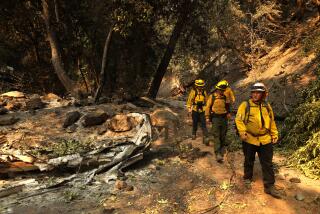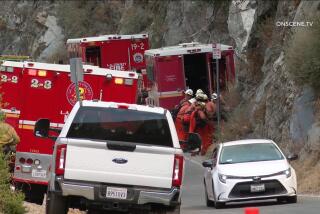Wildfire near Napa Valley burns 6,900 acres as weather conditions improve
Aided by weaker winds and cooling temperatures, firefighters reported progress Friday in taming a brush blaze that had ravaged about 6,900 acres northeast of wine country in Northern California’s Napa Valley.
The Wragg fire, named after a canyon in the area 15 miles from Napa, was about 30% contained by Friday night, officials said. More than 1,900 firefighters from around the state had joined the effort, aided by 160 engines and 16 helicopters making water drops on the rugged terrain, they said.
The partial containment of the fire off Highway 128 near the southern end of Lake Berryessa was made easier by the end of the hot gusts that had bolstered the blaze since it ignited Wednesday, according to Robbie Richard, a spokesman for the San Marcos Fire Department who was handling communications for the Wragg fire.
With the weather generally cooling and humidity rising, “it’s great conditions to stop the fire,” he said.
No injuries were reported and no fire equipment was damaged, Richard said. Just one tent-trailer and an outbuilding were destroyed. The area is remote, with several large properties for horses and cattle.
Most of the residents who were evacuated from nearby homes have been allowed to return, although two local streets remained closed, Richard said.
Officials initially said the fire was sparked by a vehicle collision. The exact cause remains under investigation, but the fire’s swift spread underscored how dry the brushland has become.
Meanwhile, crews have partially surrounded a 100-acre fire in heavy timber near South Lake Tahoe and said they were hopeful that an adjacent portion of Highway 50 linking Sacramento and Reno, Nev., soon would be reopened. That blaze erupted Thursday.
NEWSLETTER: Get essential California headlines delivered daily >>
ALSO:
More El Niño trouble: Thunderstorm sends rocks onto highway to Yosemite
Attack on the drones: Legislation could allow California firefighters to take them down
It’s critical El Niño hits Northern California. Why experts are growing optimistic.
More to Read
Sign up for Essential California
The most important California stories and recommendations in your inbox every morning.
You may occasionally receive promotional content from the Los Angeles Times.











